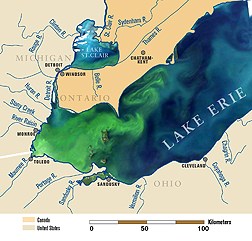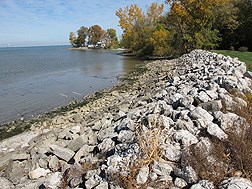Measuring Phosphorus Loss from Midwest Crop Fields
Field runoff from farms in the Lake Erie basin is often rich in soluble plant nutrients, including phosphorus. When this nutrient-rich runoff reaches the lake, the phosphorus can support abundant algal blooms that contaminate municipal drinking water supplies.
Phosphorus loss from farm fields has generally been attributed to surface runoff. But recent studies by Agricultural Research Service agricultural engineer Kevin King and soil scientist Doug Smith tracked how underground tile drains—commonly used by midwestern farmers to drain excess water from crop fields—contribute to subsurface movement of phosphorus from fertilized fields to nearby waterways.
Since 2008, Smith has been monitoring phosphorus in surface runoff and tile drainage from fields in the St. Joseph River Watershed in northeast Indiana, which is part of the larger Lake Erie Watershed. Between 2008 and 2013, he found that 49 percent of dissolved phosphorus and 48 percent of total phosphorus in the watershed were discharged via tile drains.
From 2005 until 2012, meanwhile, King monitored phosphorus levels in the discharge from six tile drains and the outlet of a headwater watershed in central Ohio. The results indicated that tile drainage contributed 47 percent of phosphorus discharge lost from the watershed. Although the amount of phosphorus in tile and watershed discharge was generally greater in the winter, spring, and fall, phosphorus concentrations were greatest in the summer, when surface water levels dropped.
Mindful of water-quality concerns, farmers in this region were generally careful to apply only the minimal amount of fertilizer needed for crop production, and King’s measurements indicated that only around 2 percent of that phosphorus was lost through tile drainage. But even with this careful management, dissolved phosphorus and total phosphorus concentrations in the tile drainage and the watershed discharge often exceeded concentrations recommended for preventing harmful algal blooms.
King’s team concluded that reducing phosphorus loss from agricultural production would require best management practices that mitigate phosphorus loss via tile drainage in the late fall, winter, and early spring when most of the phosphorus loading occurs. “We need to find ways to help farmers use phosphorus-based fertilizers and still reduce phosphorus loads in field runoff, because tile drainage is an essential part of production management in this region,” he says.
Concurring with King on what comes next, Smith says, “To reduce phosphorus loading in Lake Erie, we must not only manage fields to reduce phosphorus losses in surface runoff, but we also must manage phosphorus transport to tile drains.”
These findings provide important information to support efforts in reducing phosphorus levels in the Lake Erie Watershed. The International Joint Commission—including the United States and Canada—has set a goal to decrease annual total phosphorus loading from the Maumee River basin, the largest single tributary to Lake Erie, by 39 percent, while the Ohio Phosphorus Task Force has recommended reducing spring phosphorus loads by 37 percent. In addition, the U.S. Environmental Protection Agency has announced new goals of reducing phosphorus fertilizer runoff into the Great Lakes by more than 1,400 tons by 2019.—By Ann Perry, ARS.
This research is part of ARS National Program #211, Water Availability and Watershed Management.
"Measuring Phosphorus Loss from Midwest Crop Fields" was published in the January 2015 issue of Agricultural Research magazine.








